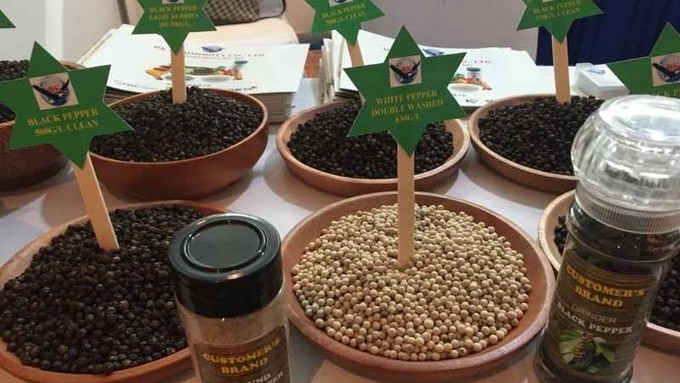Important move
Le Duc Huy, Deputy General Director of the September 2 Import-Export One Member Limited Company, which is one of the reputable pepper exporters in Dak Lak Province, said that the quality of Vietnamese pepper has improved significantly compared to 10 years ago. In addition to black pepper, the company has produced green, red, white and pickled pepper. The diversification is also part of the reason why Vietnamese pepper has conquered many markets.
Among the spices from Vietnam, pepper has been very famous in the international market and accounts for a high proportion of export turnover. Vietnam is now the world's largest pepper producer with 40% of the total output and exports to 110 countries. Despite the impact of COVID-19 pandemic on export activities, pepper exports remained stable in 2020 with 285,000 tonnes and gradually increasing prices.
Huy said the pepper industry has made efforts towards sustainable development by encouraging organic production. The abundant supply and good quality produce has helped Vietnam become an ideal destination for both domestic and foreign enterprises to open factories for deep processing of spices, including pepper. In fact, several foreign enterprises gained good effect, contributing to improving the values for businesses while raising the position of Vietnam’s pepper brand.
In addition, more and more pepper exporters have affirmed their brands in the world market. According to data from the Import-Export Department under the Ministry of Industry and Trade, the impact of the fourth outbreak of COVID-19 caused a sharp decrease in pepper exports in August. However, the average export price of Vietnamese pepper reached US$3,736 per tonne, the highest level since January 2018. This price has increased by 3.4% compared to July 2021 and by 49.4% over the same period last year.
 |
Vietnam is currently the world's largest pepper exporter. (Photo: NDO)
In the first eight months of this year, Vietnam's average export price of pepper reached US$3,321 per tonne, a year-on-year rise of 51.1%. The high price has significantly contributed to the general increase of the entire pepper industry in Vietnam. This has been considered a very positive signal in the context of the decrease in export prices of many other agricultural products.
According to Le Hoang Tai, Deputy Director of Vietnam Trade Promotion Agency under the Ministry of Industry and Trade, Vietnam has been becoming an important source of spices and flavourings, including pepper, for the world. Exporting enterprises have met the strict requirements of foreign partners and are able to provide high value-added, high quality and safe products for many leading importers and premium distribution channels in many regions around the world.
Focusing on deep processing
Despite being identified on the world pepper map in general, Vietnam is currently mainly exporting raw pepper with low processed content, as with many other agricultural products. Bui Trung Thuong, Counselor at the Vietnam Trade Affairs Office in India, noted that India is a major producer and exporter of spices and flavourings in the world. The total production of spices in this country was 3 million tonnes per year; meanwhile its exports always reach billions of US dollars. In India, spices are used for not only food, but also the food and the health support industries.
Despite exporting a large number of spices and flavourings, India's annual import turnover of these items is not small. In 2020, India imported US$1.4 billion of raw materials for processing for exports, mostly pepper. Vietnam is one of the dominant pepper suppliers for this market, but mainly raw products with low values.
 |
Deep processing helps increase value of Vietnamese pepper. (Photo: NDO)
With many years of experience in finding sources of goods from Vietnam for the EU market, Pham Van Hien, Director of the LTP Import Export BV company said in addition to a few businesses involved in deep processing of pepper for export, in general, Vietnamese pepper is mainly exported in raw form to large countries for reprocessing and is then branded by EU corporations and enterprises. As an exporting business, the company has been making a separate brand for Vietnam to distribute Vietnamese goods in general and pepper in particular to the EU as well as supermarkets and retailers. As a result, the value of Vietnamese pepper will increase.
“The EU spice importers always demand high quality. EU consumers value a healthy lifestyle, especially organic products. Therefore, in order to help Vietnamese pepper dominate the EU market, the enterprises should consider this in their production orientation”, Hien warned.
Besides, the EU countries have different prices and tastes, so Vietnamese businesses should carefully study the market. Enterprises, which are not large enough and do not have a market research department, can use online channels, available partners and fairs held in the EU to promote their products and explore the market. It is crucial to design packings in accordance with the culture and consumption habits in the countries.
Stressing the enhancement of cooperation and application of science and technology into the study and development of products, Counselor Bui Trung Thuong noted that this is the key issue for Vietnam's pepper to add value. The development of value chain is not necessarily the involvement of the perfect cycle from production to consumption, but focusing on advantageous stages. In the limited field, enterprises may call for international cooperation, then developing and mastering technology.
















